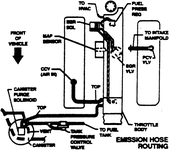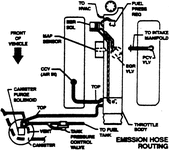BangkokDean
Well-known member
Getting close to attaching all the hoses but what and where do these connect to?



Getting close to attaching all the hoses but what and where do these connect to?

2 goes to charcoal canister not pcv
5 = port for ECT sensor
th one with the plug is for a cold start injector temperature switch if you have a 9th injector
4 = coolant to bottom of tb, if someone didn't already cut off the nipple on the tb bottom. route the coolant from there to the heater or rad and leav the #3 coolant port off too
dead rrrrrrrrrrrrrrong, Jeff is correct 2 goes to the evap cannister and is the purge line, the control vac line is t-ed of the little fitting on the bottom of the TB that also runs to the egr solenoid
dead rrrrrrrrrrrrrrong, Jeff is correct 2 goes to the evap cannister and is the purge line, the control vac line is t-ed of the little fitting on the bottom of the TB that also runs to the egr solenoid

top is for valve cover breather
bottom for canister purge
threaded holes in intake for either cold start injector sensor and CTS on 85-88 on 89-92 onlt one hole is open for CTS sensor.
PCV gets its vacuum from in front of the drivers side rear two runners
1/8 inch vacuum port under under throttle body is for egr
right rear plenum port 85-89 for hvac and f/p regulator, 90-92 had 3 ports in this location f/p regulator, hvac, map sensor.
case closed



What and where is the egr solenoid, is this the egr?If not what connects to this?the control vac line is t-ed of the little fitting on the bottom of the TB that also runs to the egr solenoid

What and where is the egr solenoid, is this the egr?If not what connects to this?the control vac line is t-ed of the little fitting on the bottom of the TB that also runs to the egr solenoid

What and where is the egr solenoid, is this the egr?If not what connects to this?the control vac line is t-ed of the little fitting on the bottom of the TB that also runs to the egr solenoid

In your other thread, I didn't spot that large ~3" diameter EGR valve that goes on top of the mani, underneath the plenum, held on by two bolts, you should have a EGR block off plate bolted in place, otherwise you have two open holes in that mani there, one to the main intake passages, another open to the exhaust pressure, what you show in you second pix is the fuel pressure regulator.....I presume with running LPG, you not need any gasoline, so that is moot, unused.....
Hot water kept it from icing in cold/rainy weather, I had the experience long time ago on a old Dodge van that never ran good in cold moist weather, so me and a buddy went for a ride with air cleaner and dog house off, and witnessed first hand the carb icing up with the cold moist air, the vacuum drop of it entering the carb caused the moisture to freeze and ice up on the carb air inlet area, choke, horn and the engine went nutz, so to keep same thing from happening, hot water was used, not an issue here in Florida, damn sure is when things are just right up north though.....

What and where is the egr solenoid, is this the egr?If not what connects to this?the control vac line is t-ed of the little fitting on the bottom of the TB that also runs to the egr solenoid

In your other thread, I didn't spot that large ~3" diameter EGR valve that goes on top of the mani, underneath the plenum, held on by two bolts, you should have a EGR block off plate bolted in place, otherwise you have two open holes in that mani there, one to the main intake passages, another open to the exhaust pressure, what you show in you second pix is the fuel pressure regulator.....I presume with running LPG, you not need any gasoline, so that is moot, unused.....
Hot water kept it from icing in cold/rainy weather, I had the experience long time ago on a old Dodge van that never ran good in cold moist weather, so me and a buddy went for a ride with air cleaner and dog house off, and witnessed first hand the carb icing up with the cold moist air, the vacuum drop of it entering the carb caused the moisture to freeze and ice up on the carb air inlet area, choke, horn and the engine went nutz, so to keep same thing from happening, hot water was used, not an issue here in Florida, damn sure is when things are just right up north though.....

Ok there is a plate in the middle of the intake manifold held down with two bolts so I guess that is what you are talking about(see picture). Yes I will be running LPG but also gasoline if needed so the fuel pressure regulator will need to be operational. So I will need to know what to connect it to? The weather here is actually the same as south Florida but 11 months a year, so hot water is not necessary. So what I now see is all I need to connect is the #1 to the PCV as shown in the picture on the yellow car, #2,#3,#4 and #5 wont be used. And I just need to know what to connect the fuel pressure regulator to. The fuel rail in and return lines are easily easy to connect to the tank.

Thanks for the info. One more question. Can this port on the intake be used for the PCV valve?

